Why ‘boring’ tech wins: the power of a proven tech stack
In the race to ship faster, scale bigger, and innovate louder, it’s tempting to reach for the newest tool available. A fresh framework or a new programming language sound exciting. However, when it comes to delivering products that work (and keep working), it’s often the so-called ‘boring’ tools that quietly win.
Why? Because they’ve been tested and trusted – not just in theory, but in the real world. Welcome to the power of the proven tech stack.
The proven tech stack: what it is?
The proven tech stack isn’t just old. It’s reliable, well-understood, and solves problems without creating new ones. Think Java, Git, or Markdown. These aren’t antiques – in fact, they continue to evolve while staying true to their core functions.
New, shiny tools are tempting. But when suddenly your focus must shift from delivery to firefighting, the cost becomes clear: projects slow down, teams burn out, and what started as ‘innovative’ turns into a problem.
A story about hammers (and why it matters in tech)
Let’s start with a story from an entirely different field to set the stage.
I recently watched an experienced carpenter test a strange new hammer – one with no head and a weighted handle that you grip like a fist. The design looked futuristic. However, when put to work, the results were disappointing: the new hammer was far less accurate, took longer to drive in nails, and even caused hand pain. Worse still, when trying to remove nails, it often damaged their heads. Despite its unconventional looks, it didn’t outperform the traditional hammer. In fact, it made the job harder and less efficient.
Innovation vs. efficiency
You might argue, “But the carpenter was simply more accustomed to the old hammer!” While it’s true that experience plays a role, does it change the outcome? A bent nail is still a bent nail. If this hammer were used in a real home renovation, complaints would surely follow.
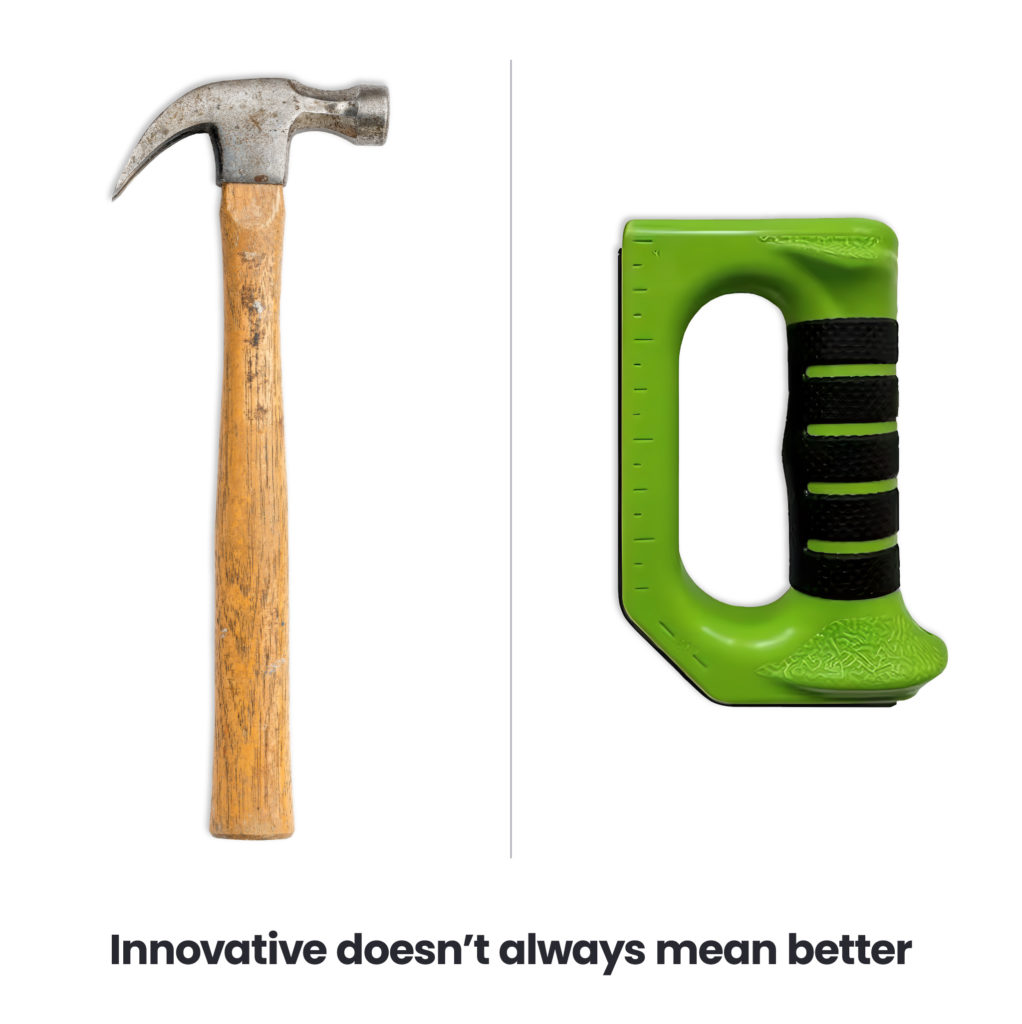
The lesson is, regardless of how innovative a design may be, if the tool doesn’t get the job done efficiently, it’s not worth the hype.
It’s all about getting the job done in software development
The same principle applies to technology. Just because a tech stack is new and exciting doesn’t mean it will be the right fit for your needs.
The technology might seem ‘boring’, but if it’s chosen based on sound project requirements and consistently delivers reliable, long-lasting results, that’s what truly matters.
In all fields (whether it’s carpentry or software development), experts are valued for their proven expertise rather than for chasing trends. If I’ve spent ten years as a Java developer, my role is to deliver Java solutions, not to create confusion by experimenting with Scala or Rust for the novelty’s sake. If I introduce unnecessary complexity by using a different programming language, should I be surprised when my colleagues struggle to understand my code, or when bugs multiply?
The moral of the story: innovation is all well and good, but only if it actually makes things more efficient.
Real-life examples
When it comes to the ‘boring’ technologies I use daily – aside from Java, which I’ve already mentioned – two tools (or rather, concepts) stand out. These are regex and Markdown, and below I’ll show you how they can simplify your work.
Regular expressions (regex)
I first encountered regex thanks to Vim, which I started using four years ago (shortly before Emacs made its way into my toolkit). However, regex is not just a Vim trick. The concept is about 40 years older and has firmly embedded itself in many text editors and programming languages. These days, regex is an integral part of my work in IntelliJ, various text editors, Unix tools, and even as a tool for application logic.
Regex is both a gift and a curse. It’s like a magic spell that, when wielded correctly, can transform chaotic text into structured perfection. But a tiny misstep? Congratulations, you’ve just summoned an unreadable incantation that no one (including future you) can decipher. And let’s not forget the potential headache of forgetting to write unit tests for your regex patterns.
Still, regex remains a staple tool for solving one specific problem: handling repetitive, tedious editing tasks.
For instance, consider a class like Numbers that needs refactoring. The example below is simplified, but imagine hundreds of lines, all following a similar pattern, waiting to be adjusted.

Instead of manually tweaking each line, you use regex. One pattern defines what needs to change, the other specifies how to change it.

In an instant, every matching line is transformed:
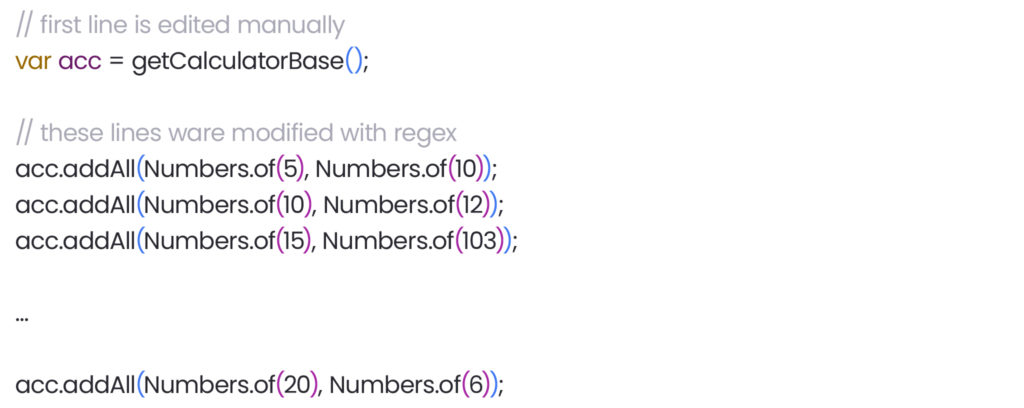
Looking at the result, you realise there’s still room for improvement. A replacing regex simplifies it even further:

Now, you’re left with this much cleaner version:

A final round of manual polishing, and voilà:
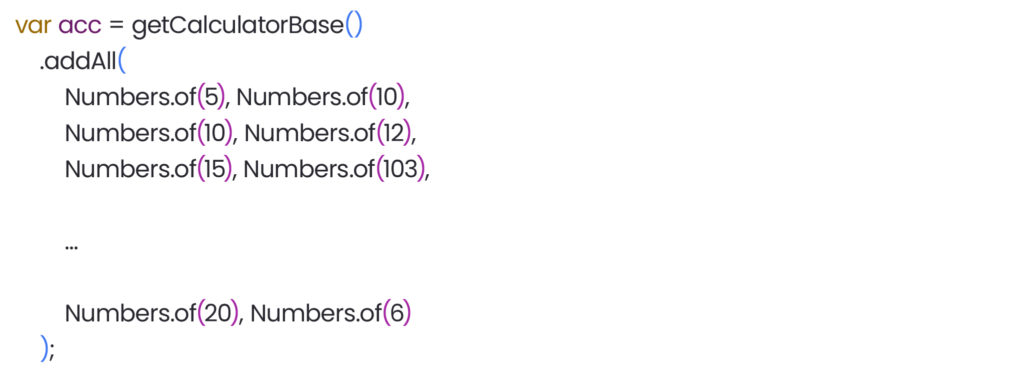
Here’s the beauty of it: whether you’re updating one line or a thousand lines, writing the regex takes the same amount of time (true story).
As you can see, you could go through each line and manually fix them. Or you could use regex and watch it make precise, bulk changes in a fraction of the time it would take to do so manually.
Markdown
Back in 2004, John Gruber introduced Markdown, a lightweight markup language designed for simplicity. In less than a year, it reached its final stable version (v1.0.1), and, surprisingly, that version has remained unchanged ever since.
This is because Markdown was built on a brilliantly minimalist idea: it uses a few simple markers to format text, such as headers, bold and italic fonts, lists, enumerations, and a few other formatting essentials. Back then, this was all most developers needed.
While you could achieve the same (and much more) by writing HTML directly, please compare these two examples below.
HTML
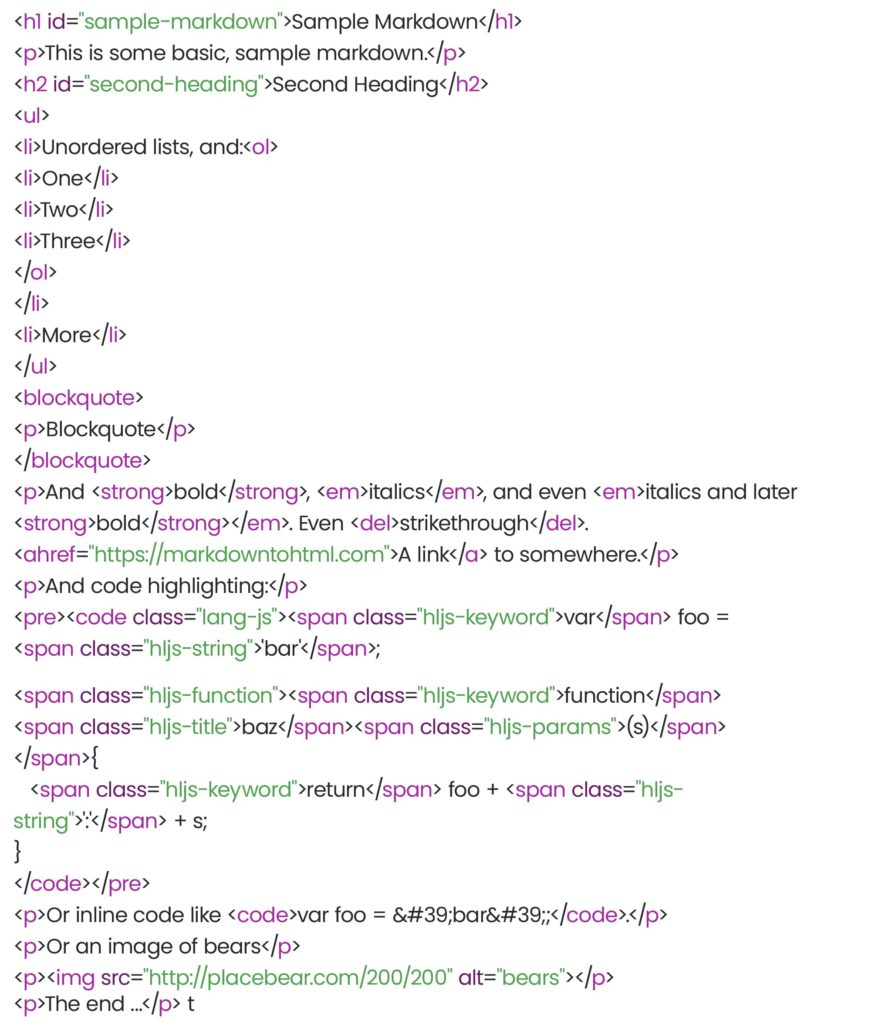
Markdown
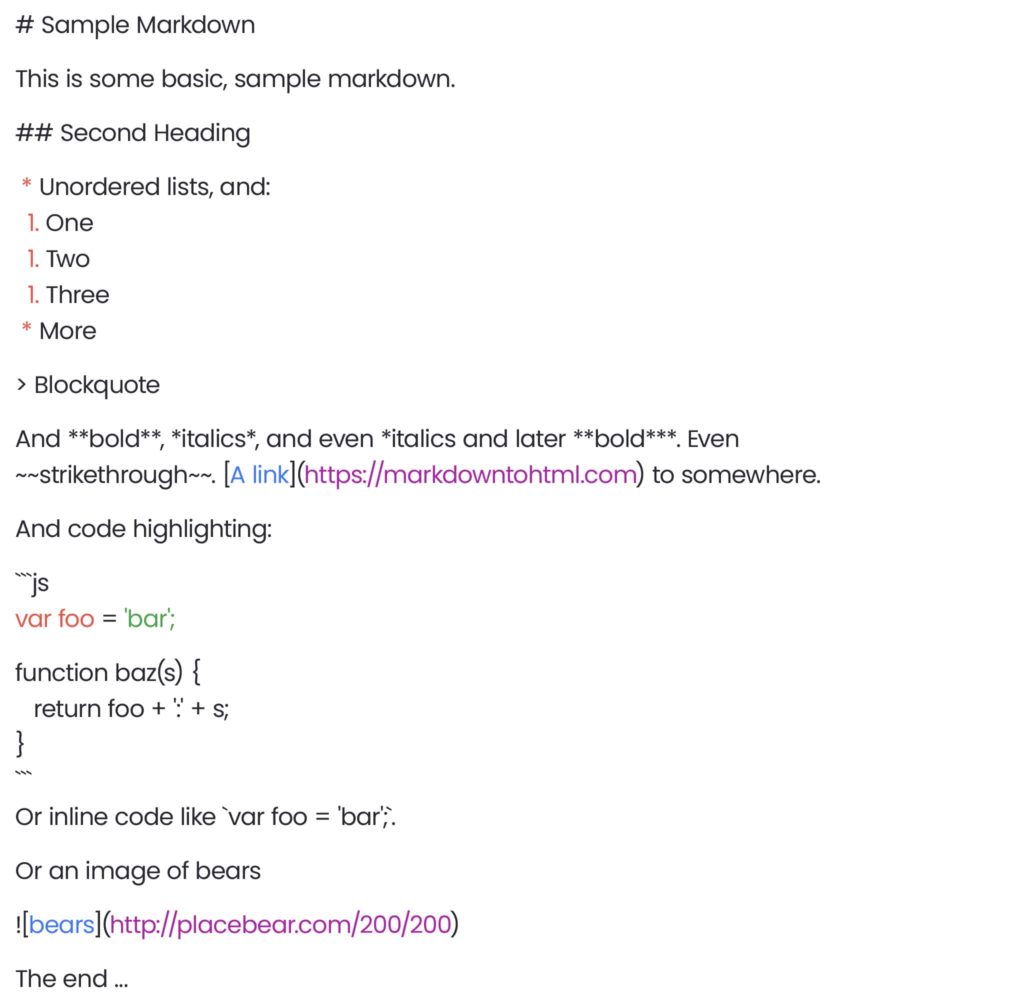
I mentioned earlier that Markdown’s first and only official version was released in 2004. Interestingly, nearly two decades later, most people writing text still only need a small subset of HTML features to accomplish their tasks.
Of course, they’re not using Markdown exactly in the same way as in 2004. Instead, they work with one of its many modern flavours – variations that expand on the original idea while keeping its core simplicity intact. These Markdown derivatives are actively developed, new editors appear regularly to support them, and entire applications have been built upon basic Markdown while adding specialised extensions for various use cases.
If you’re a developer, you may have noticed that many widely used tools generate Markdown files by default. That .md extension in README.md? It’s automatically created whenever you start a new repository on GitHub, GitLab, or Bitbucket. Even Atlassian products like Jira and Confluence have supported direct Markdown editing for years (at least before corporate decision-makers decided to take them in a different direction).
Through all these changes, Markdown’s core strength remains the same: simplicity.
The fact that README.md is automatically created in every new repository is no accident; it serves as a subtle reminder from Git forges that Markdown just excels at writing documentation.
Every year, new proprietary tools flood the market, each promising to revolutionise how we write and collaborate. They come with fancy features, sleek interfaces, and AI-powered assistants. Let’s be real: do you really need all that? What could be better than a universal format that works with any text editor?
- IntelliJ? Supported.
- Visual Studio Code? Supported.
- Notepad.exe? Supported. (And you don’t even need syntax highlighting to write Markdown efficiently.)
Markdown + Git = the perfect workflow
Need a documentation solution for your entire team? You already have one. If you’re even slightly experienced as a developer, you’ve been using it for years. Version Control systems (like Git) are the answer.
Think about it – this workflow has become second nature to developers:
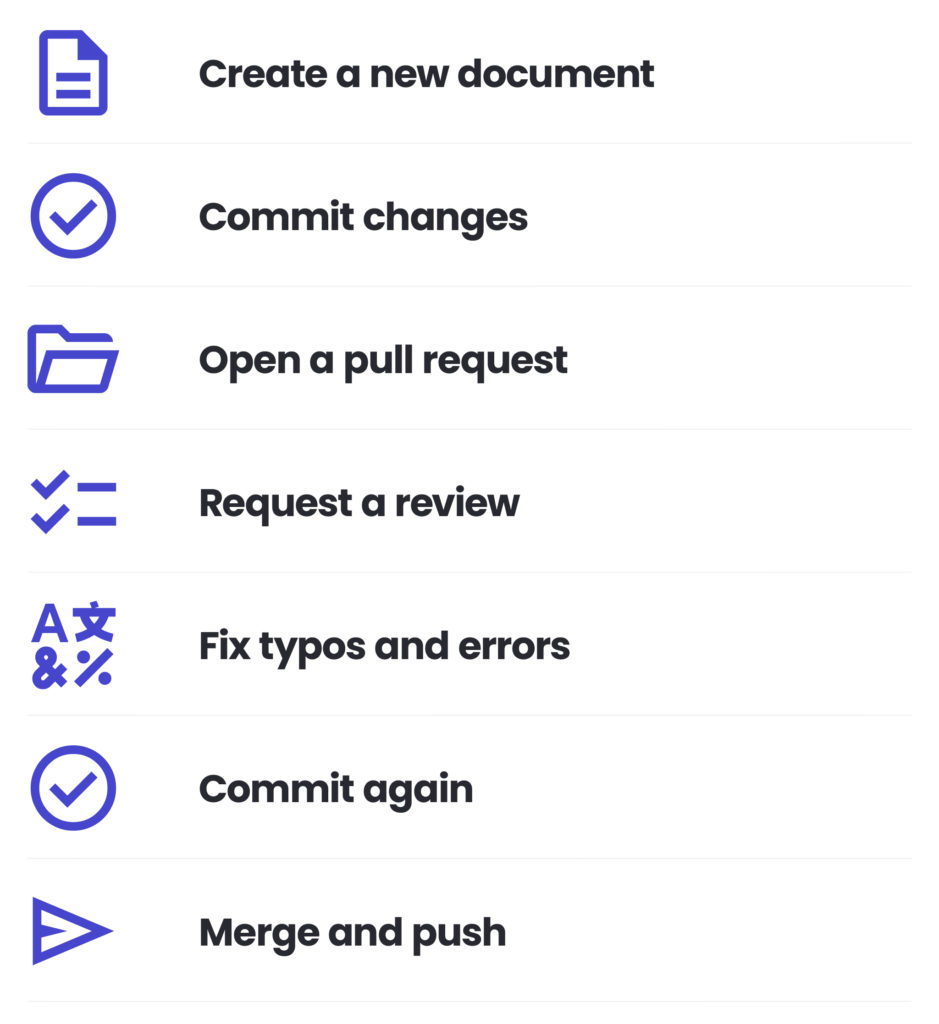
The best part is total ownership of your files. If you ever decide you no longer want to use GitHub, all your Markdown files are still on your computer. There is no lock-in, no proprietary complications, and no special software required to read them.
In the end, Markdown is not just ‘good enough’ for documentation; it is the gold standard.
In praise of ‘boring’ technology
I’ve walked you through two specific examples, regex and Markdown, but these are just the tip of the iceberg. The real takeaway is not that you should drop everything and start using them everywhere (though I wouldn’t discourage you from doing so).
Instead, it’s about adopting a certain mindset: a habit of questioning whether the latest and greatest trends are truly necessary when tried-and-tested tools already solve your problem.
Before jumping on the next technology, ask yourself the following questions:
- Is the old solution reliable and sufficient for the task?
- Is it independent of a single company’s decisions?
- Does the team already understand it?
- Will it be easy to onboard new hires?
- Have you ever struggled to find explanations for its quirks?
- Are there thousands of expert answers to obscure issues?
If the answer is yes to most of these questions, congratulations – you’ve found a ‘boring’ technology that works.
‘Boring’ = more time for what’s important
A stable, predictable tech stack means less time fighting with your tools and more time focused on solving real business problems. It frees up energy for strategic goals instead of getting caught up in debugging edge cases.
Now, contrast that with this scenario:
- You pick something fresh and exciting.
- You feel great for a week, maybe even a month.
- You update your CV with ‘cool technology’.
But then…
- As the project matures, your codebase no longer resembles the tidy examples from the official documentation.
- Your client grows impatient as progress slows.
- Features are released less frequently while bugs linger.
- You realise that comprehensive troubleshooting resources don’t exist yet.
Was the trade-off worth it?
Addressing the concerns
There’s one lingering question we haven’t addressed yet.
“If I stick with so-called ‘boring’ technologies, do I risk professional stagnation? Will I become that developer who struggles to find a job in the next five years?“
Let’s take a deep breath. I have two thoughts on this.
1. The best tech was already ‘boring’ before you were born
Ever heard of coupling and cohesion? They are fundamental principles of software design – concepts that date back to the 1970s, long before object-oriented programming, domain-driven design, and most of what we consider modern best practices. Yet, they remain just as relevant today.
This is because many modern best practices and architectural paradigms are simply refinements or special cases of old ones. Master the principles, and you’ll be able to recognize the patterns behind new trends, without needing to chase every new technology blindly. You’ll understand the dependencies, the trade-offs, and (most importantly) when a trend is merely a repackaged idea with better marketing.
2. How ‘new’ becomes ‘boring’
Not every cutting-edge tool makes it to the ‘boring’ but essential club. The reality is that not every new tool survives long enough to earn that status. If you attend IT conferences (especially those sponsored by vendors) you might get the impression that switching to the latest solution is urgent, necessary, and guaranteed to be successful. The message is always the same:
“You HAVE to switch to this technology. Yesterday.”
“Everyone who matters is using it.”
Let’s flip the perspective. Imagine ten promising startups, each pitching their revolutionary tool. A year later, nine of them are gone. How many of those failure stories will you hear at next year’s conference? None.
What you’re witnessing is survivorship bias: the illusion that every new tool is a success because only the survivors get celebrated.
So, if a new technology is truly destined to become a reliable one… why not wait and see if it actually survives?
When to take the leap (and when to sit back with popcorn)
That said, if something genuinely excites you – or seems too promising to ignore – go ahead and explore it! Just be cautious about deploying it in situations where failure could significantly impact your career.
Look at how Rust was introduced to the Linux kernel. Instead of rewriting core components overnight, they started small, allowing Rust only in optional modules. If it works, great. If Rust’s integration doesn’t go as planned, the core system remains unaffected.
Final thoughts: not everything old is worth keeping
Of course, not all old tools deserve to remain in our stack. Some technologies fade away for good reasons, such as proprietary formats, legal uncertainties, or sheer inefficiency. The key is knowing the difference between ‘boring but great’ and ‘outdated for a reason’.
The tools that matter most aren’t the ones that impress recruiters or look trendy on a slide deck. They’re the ones that get the job done, day after day, without fail. So next time you’re picking a tech stack, remember: boring is beautiful.
About the author
RECOMMENDED ARTICLES


![[hero] the power of a proven tech stack](https://spyro-soft.com/wp-content/uploads/2025/04/hero-the-power-of-a-proven-tech-stack-1024x684.jpg)
